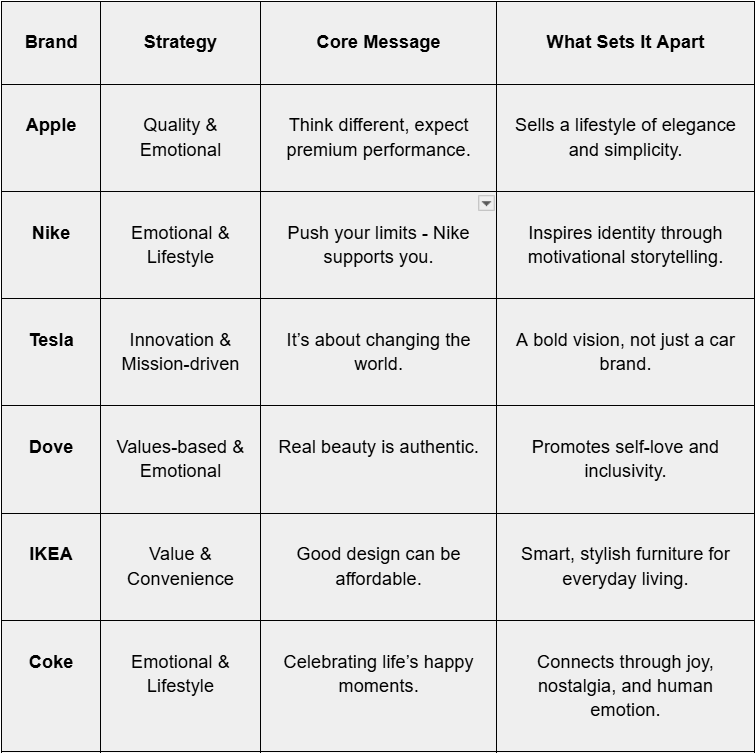Ultimate Guide to Brand Positioning - What It Is and Why It Is Crucial?
In today’s crowded market, people don’t just buy products, they buy into brands. What makes someone pick Nike over Reebok or Starbucks over a local café? It all comes down to brand positioning. It is the strategy behind how your brand is perceived and why someone should choose you over others. Take Tesla, for example. They didn’t just enter the car industry, they redefined it. By positioning themselves as an innovative brand focused on sustainability and cutting-edge technology, Tesla set itself apart from traditional automakers. That is the power of clear brand positioning. In this guide, we’ll break down what brand positioning means, why it is essential, and how you can create a positioning strategy that makes your brand stand out in the market and stick in people’s minds.
What is Brand Positioning?
Brand positioning is the process of defining how you want your brand to be perceived in the minds of the target audience. It goes beyond just having a logo or tagline. It’s about the unique value your brand represents and how that value connects with your customers. To put it simply, it is about establishing a differentiated identity in a competitive market and clearly highlighting what makes your brand different and valuable. Whether you are focusing on innovation, affordability, premium quality, or outstanding service, brand positioning helps shape how people think and feel about your business.
Think about two popular coffee chains, Starbucks and Dunkin'. Starbucks presents itself as a premium brand. It is not just about the coffee, it's about the whole experience. From the cozy vibe to the custom drinks, Starbucks is designed for people who treat coffee as part of their daily lifestyle, not just something to drink. Dunkin', on the other hand, keeps things simple and quick. It is affordable, familiar, and perfect for someone who just wants to grab a quick cup and get on with their day.
Both sell coffee, but how they position themselves makes a big difference in how customers perceive them and who they choose to buy from. This is what brand positioning means. It defines how your brand is different and why someone should choose you over the competition.
Why Brand Positioning Matters Today
In today’s competitive market, consumers are offered many choices. From the moment they wake up to the time they go to bed, they are exposed to hundreds of brands every day. So, how do you make sure your brand gets noticed, remembered, and chosen? That’s where brand positioning becomes essential.
A well-defined brand position helps your business stand out in a sea of sameness. It tells people who you are, what you do, and why you’re different, all within a few seconds. When people understand what your brand stands for and how it fits into their lives, they’re more likely to connect with it emotionally and stay loyal over time. Below are the reasons why strong brand positioning is crucial in today's world.

- Helps differentiate your brand - In a marketplace, having a unique voice and value proposition sets you apart from competitors.
- Builds clarity - Internally, it aligns your team around a shared vision and message. Externally, it helps your audience understand your value instantly.
- Guides marketing strategy - From content and campaigns to packaging and pricing, your positioning shapes how you show up across all channels.
- Boosts brand loyalty - When customers feel a connection to your brand, they are more likely to stick around and recommend you to others.
- Supports growth - As your brand scales, a clear position keeps your identity consistent, even as your offerings evolve.
Whether you are launching a new product, entering into a new market, or trying to reinvent your image, brand positioning gives you the strategic foundation to make every move count. In short, without clear positioning, your brand risks getting lost in the noise. With it, you have a much better chance of making a real, lasting impact.
Types of Brand Positioning Strategies
Choosing the right brand positioning strategy is a major step in defining how you want your audience to see your brand. It’s not just about being different, it’s about being relevant and memorable. Below are the most widely used strategies.
Benefit Positioning
This one highlights the specific benefit your product offers. It focuses on what customers gain by choosing your brand, whether it’s convenience, confidence, health, or time savings.
Example: Colgate promotes stronger, healthier teeth as the key benefit.
Problem/Solution Positioning
This approach positions your brand as the answer to a specific problem your audience faces. It is ideal for brands that effectively solve pain points.
Example: Head & Shoulders targets dandruff, offering a clear solution to a common hair problem.
Competitor-Based Positioning
In this type, your brand is positioned directly against a competitor to show how you are better, faster, cheaper, or more innovative. It is used in crowded markets to draw comparisons.
Example: Pepsi vs. Coke. Pepsi has historically positioned itself as the youthful alternative to Coke.
Value-Based Positioning
This strategy emphasizes getting the most for your money. Brands that lead with affordability and decent quality often use this approach.
Example: Walmart - “Save Money. Live Better.”
Quality-Based Positioning
Brands that offer better quality, great design, or top performance use this strategy to show why their products are worth a higher price.
Example: Apple is known for its high-quality products and design.
Convenience-Based Positioning
It focuses on easy access, speed, or simplicity. It is ideal for busy customers looking for hassle-free solutions.
Example: Amazon- fast delivery, one-click purchases, and 24/7 shopping.
Customer Service Positioning
Brands that shine in post-purchase support or customer care can make this their strongest selling point.
Example: Zappos is known for outstanding and friendly customer service.
Niche or Specialized Positioning
Ideal for brands serving a specific market or group. It’s about being the best at solving a very particular need.
Example: GoPro is designed specifically for action and adventure filming.
Innovation-Based Positioning
This focuses on being ahead of the curve and launching new ideas, tech, or solutions. It is great for startups and trendsetters.
Example: Tesla is known for breaking norms in the automotive and energy industries.
Emotional Positioning
This strategy taps into how your brand makes people feel. It often connects with values, identity, or aspirations.
Example: Nike’s “Just Do It” inspires motivation, empowerment, and self-belief.
You don’t have to stick to just one. Many successful brands combine two or more of these strategies for greater impact. The key is consistency. Your positioning should be clear, aligned with your audience, and reflected across every touchpoint.
Real-World Examples of Effective Brand Positioning
The most successful brands don’t just tell you what they offer, they show you how they fit into your lifestyle, solve your problems, or reflect your values. Let’s break down how some well-known brands have nailed their positioning.

Steps to Create a Powerful Brand Positioning Strategy
A strong brand positioning strategy helps your business stand out, connect with the right audience, and build lasting loyalty. Below are the key steps to help you create an effective brand positioning strategy from the ground up.
Understand Your Target Audience
The foundation of any good brand positioning starts with knowing who you are trying to reach. You need to understand your audience,
- Demographics (age, gender, income, location)
- Psychographics (lifestyle, interests, attitudes)
- Needs and pain points (what problem are they trying to solve?)
- Decision-making factors (do they value price, quality, convenience, or status?)
You can’t appeal to everyone. However, when you know exactly who your brand is for, your message will have a much greater impact.
Analyze Your Competitors
Before you can stand out, you need to know what you are up against. Look at your competitors and ask,
- What are they promising their customers?
- How are they perceived in the market?
- What are their strengths & weaknesses?
- Are there gaps in their offerings that your brand can fill?
Create a competitor matrix or positioning map to see how your brand compares in terms of pricing, values, audience, and benefits. Identifying opportunities for differentiation is key to creating a unique brand identity.
Identify Your Unique Value Proposition (UVP)
Your Unique Value Proposition (UVP) is the clear answer to the question: “Why should a customer choose you?” It should reflect,
- What you offer
- How does it solve a specific problem
- What makes it different from or better than competitors
Craft Your Brand Positioning Statement
Now that you understand your audience, competition, and UVP, it is time to turn all that insight into a clear, concise brand positioning statement. A strong brand positioning statement should define who your target audience is, what your brand offers, how it stands out from the competition, and why customers should believe in it. A well-written positioning statement isn’t meant to be a slogan or tagline, it is an internal guide that helps align your messaging, strategy, and customer experience.
Align Your Brand Messaging Across All Touchpoints
Once your positioning is clear, consistency is everything. Your website, social media, product packaging, customer support, and advertising must all reflect your brand’s tone, message, and values.
- Use a consistent brand voice & visual identity.
- Reinforce your UVP in all your copy.
- Align team members with brand guidelines.
Test, Gather Feedback, and Refine
Once your strategy is in place, don’t set it and forget it. Test how your brand is received by
- Conducting customer surveys.
- Listening to social media feedback.
- Analyzing reviews and testimonials.
- Tracking brand sentiment over time.
If something isn’t working, whether it’s the message, tone, or target market, don’t be afraid to adjust. A brand needs to evolve with its audience and the market. Ongoing feedback ensures you stay relevant and practical.
Common Challenges
Even well-established businesses can struggle to clearly define who they are and how they’re different. Below are some of the most common challenges brands face when it comes to positioning.
- Many brands struggle to define what they truly stand for. When your brand message is too broad or vague, it becomes difficult for people to remember or relate to it. If a customer can't quickly understand what makes your brand different, they are likely to move on to one that communicates more clearly.
- A brand might present itself differently across various channels, like social media, websites, ads, or customer support. This inconsistency can confuse your audience and damage trust. If your tone, visuals, or core message constantly shifts, customers won’t know what to expect from you.
- Without understanding what your competitors are doing, you risk positioning your brand in a crowded or already-claimed space. Worse, you might accidentally sound just like everyone else. Studying your competitors helps you identify market gaps and define a positioning that is truly your own.
- Saying things like “we offer great service” or “we care about our customers” isn’t enough anymore, everyone says that. If you can’t clearly show how your brand is different or better in a specific, meaningful way, your message will be lost in the noise. Strong differentiation is what helps a brand stay top of mind.
- Sometimes, brands build their positioning around assumptions rather than actual customer data. If your message doesn’t resonate with your real audience, what they value, want, or need, it won’t be effective. Knowing your audience inside out is crucial for creating a message that sticks.
- Even successful positioning strategies can become outdated over time. Markets shift, trends change, and customer expectations evolve. A brand that stays stuck in its original narrative may lose relevance. Refreshing your positioning periodically helps you stay aligned with what your audience cares about today.
Mistakes to Avoid
Even good brands can make missteps that weaken their position in the market. Being aware of these mistakes can save you time, money, and reputation.

- A broad message often connects with no one. Focus on your ideal audience and build deeper connections.
- Saying “high quality” or “great service” isn’t enough. Clearly highlight what makes your brand unique.
- Mixed visuals or messaging across platforms can confuse people. Keep your tone and style consistent.
- Don’t make big claims you can’t deliver. Trust is built through real experiences, not hype.
- Without knowing what others are doing, you risk blending in. Study the market and stand out smartly.
- You might believe your brand stands for one thing, but your customers may see it differently. That disconnect can hurt your brand. Conduct regular surveys, collect feedback, and monitor reviews to stay aligned.
- Positioning isn’t just specs, it is also about values, feelings, and identity.
- Markets evolve, customer expectations shift, and new players enter the space. Stay flexible and open to change.
- Facts may drive decisions, but it is an emotion that builds lasting loyalty. Great positioning speaks to both the head and the heart.
Measure the Impact of Your Brand Positioning
Creating a brand positioning strategy is just the beginning, you also need to track how well it's working. Measuring its impact helps you understand if your brand message is resonating, where you are winning, and where you might need to adjust. Below are the steps to measure it.
- Run surveys, collect feedback, or check online reviews to see how people describe your brand. Do their words match the positioning you aimed for?
- Are people recognizing your brand in a crowded market? Use brand recall tests or monitor search volume and social mentions to gauge visibility.
- Track how people interact with your content across platforms. Higher engagement means your message is connecting.
- Evaluate whether your positioning is delivering tangible results. Are new customers choosing you for the reasons you want to be known for?
- A strong brand position leads to repeat business. Monitor retention rates, reviews, and referral activity to measure loyalty.
- Compare your performance with competitors. Are you gaining market share? Do customers perceive you as a leader or follower in your space?
By tracking these metrics regularly, you will know if your brand is truly standing out or if it is time for a strategy refresh.
Position Your Brand for Long-Term Success
Brand positioning isn’t just a marketing exercise, it is the backbone of how your business is perceived, remembered, and trusted. Whether you are launching a new product or refreshing your existing brand, positioning gives you a clear direction and helps you connect with the right audience. Take the time to define your unique value, speak directly to your ideal customer, and stay flexible as the market evolves. When done right, brand positioning can be the difference between blending in and becoming a brand people truly believe in.
For businesses looking to craft a clear, compelling brand position that truly stands out, partnering with a strategic agency like Become can make all the difference. Your brand deserves a distinct voice. Connect with Become and let’s position it for impact.



















.svg)
